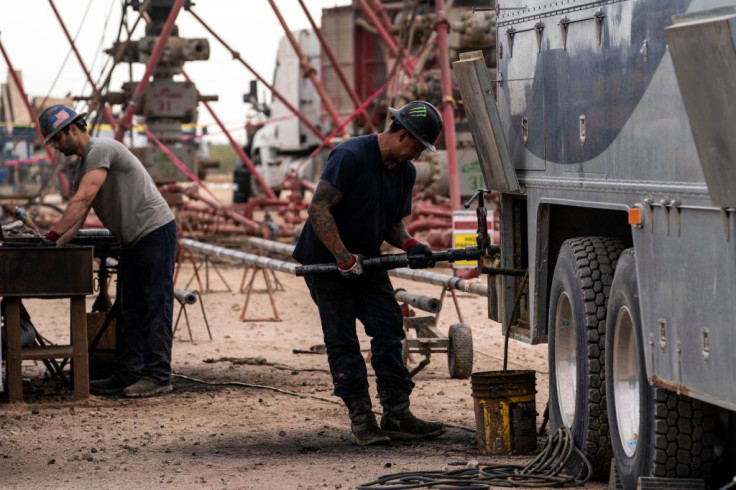Persistent Low Crude Prices May Spell Doom For Debt-Ridden US Shale Industry

KEY POINTS
- WTI crude prices were trading as low as $42 on Friday
- Wall Street has grown weary of shale's high costs, low profit generation
- The shale industry is heavily indebted
Falling crude oil prices have placed an additional burden on the already beleaguered U.S. shale oil industry.
As the Organization of the Petroleum Exporting Countries failed to achieve production cuts and the swirling coronavirus epidemic crimps global energy demand, crude oil futures have been plunging.
As of 2:40 p.m. EDT on Friday, West Texas Intermediate futures were priced at only $41.28 per barrel, a 10.2% drop from the prior day.
Since Jan. 24, WTI crude has dropped more than 28% -- largely due to falling demand by virus-struck China.
“Current forecasts of crude oil demand have fallen off a cliff. As China is the largest consumer in the world, the unclear impact of the coronavirus is driving WTI lower and lower,” said KKM Financial founder and CEO Jeff Kilburg.
Lower crude prices could spell doom for cash-strapped shale drillers, who desperately want OPEC to reduce output in order to support oil prices.
The Bakken formation of North Dakota is the crown jewel of U.S. shale production -- in April 2013, the U.S, Geological Survey estimated the Bakken formation may hold up to 7.4 billion barrels of oil. The Permian basin in the southwestern U.S. is another huge shale producer.
Last year, shale production grew by more than 1.2 million barrels a day to an all-time high of 12.2 million b/d, said the Energy Information Administration, a division of the U.S. Department of Energy.
However, Artem Abramov, head of shale research at Rystad Energy Oil & Gas Consulting, indicated that U.S. shale producers spent $400 billion of capital between 2008 and 2018 without provide much in return. As a result, Wall Street shut off the spigot, weary of an industry that produced little in profit.
Put simply, the fracking revolution has failed to generate much money.
“The whole [shale] industry’s investment case is predicated on OPEC voluntarily ceding market share,” said Matt Portillo, a managing director at Tudor, Pickering, Holt & Co, a Houston-based investment bank. “[West Texas Intermediate] at $50 a barrel does not work for U.S. shale.”
“The capital markets are closed and productivity is plateauing,” Portillo added.
Last month, ratings firm Moody’s pointed out that more than 60% of the staggering $86 billion of shale debt that is coming due over the next four years were issued by junk-rated companies, thereby suggesting a “higher degree of default risk for the industry.”
These speculative-grade maturities will peak in 2022, double the amount of investment-grade maturities that year, Moody’s added.
Rises in bankruptcy could make shale even more unpopular on risk-averse Wall Street.
Moody’s cited three specific shale-related companies -- Antero Resources (AR), EQT Corp. (EQT) and Chesapeake Energy (CHK), which in the aggregate hold debt of more than $5 billion due to mature between now and 2024 -- that face a “particularly challenging” refinancing outlook.
“While these companies have already taken some measures to address maturities, more needs to be done,” added Moody’s.
Steve Schlotterbeck, the former CEO of EQT, admitted earlier this year: “The shale gas revolution has frankly been an unmitigated disaster for any buy-and-hold investor in the shale gas industry with very few limited exceptions.”
Companies like EQT and Chesapeake have lost as much as 90% of their peak value.
Jed Graham wrote on Investors Business Daily: “The U.S. is awash in cheap shale oil and gas. After decades of declining U.S. oil output, the fracking revolution unlocked vast oil and gas deposits and made America the world's No. 1 oil producer.”
But now, shale’s growth phase may be ending
"We expect zero growth next year, and if the coronavirus continues, we could have negative growth this year," said Raoul LeBlanc, vice president for energy at IHS Markit. "[Shale] is one of the most capital-intensive businesses in the world. Investors that were willing to fund this massive growth are starting to focus on profitability and getting money back.”
LeBlanc added that: "In the long run, demand for oil is uncertain, at best. Fear is starting to decapitalize the sector, compounding the lousy returns and making it easy for people to say 'I'm not going to invest here.’”
A recent EIA Drilling Productivity Report revealed that production in all major shale basins outside of the Permian Basin have begun to decline.
JBC Energy reduced its shale supply growth forecast to 760,000 bpd in 2020, down 120,000 bpd from previous estimate. “The currently suppressed price environment, which is not expected to disappear anytime soon, makes it more difficult for completion rates to achieve their previously expected recovery,” JBC said.
Last week, Olivier Le Peuch, the chief executive of Schlumberger (SLB), said he expected U.S. shale oil production to slow down to 600,000 to 700,000 bpd this year and then crater to only 200,000 bpd next year as low prices continue to hammer the sector.
Le Peuch further warned that unless the oilfield industry creates a newer and cheaper extraction technology, U.S. shale oil production will eventually be stifled.
© Copyright IBTimes 2025. All rights reserved.





















